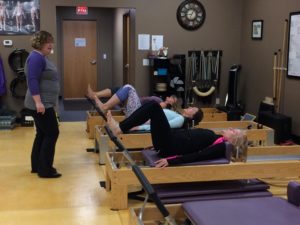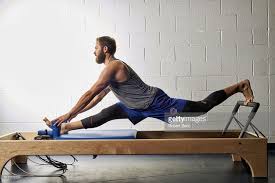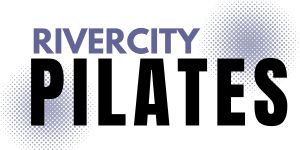 I think we could all agree that not all workouts are for EVERY body. For example….running is not the best choice for EVERY body. If you are overweight or have knee or hip issues…running is not going to feel good on your body and its not necessarily good for it as it may exacerbate pre-existing conditions. Another example…if you have low back problems, jumping into a fitness program that does a lot of burpees and planks may actually make your back pain worse if you are not using good form. Yet if you are an elite athlete, or fairly healthy with no pre-existing conditions this might be the perfect type of workout for you. I truly believe there is not one exercise program that is the perfect fit for EVERY body…although I do think there might just be a piece of equipment that effectively trains EVERY body- the Pilates Reformer. Let me explain.
I think we could all agree that not all workouts are for EVERY body. For example….running is not the best choice for EVERY body. If you are overweight or have knee or hip issues…running is not going to feel good on your body and its not necessarily good for it as it may exacerbate pre-existing conditions. Another example…if you have low back problems, jumping into a fitness program that does a lot of burpees and planks may actually make your back pain worse if you are not using good form. Yet if you are an elite athlete, or fairly healthy with no pre-existing conditions this might be the perfect type of workout for you. I truly believe there is not one exercise program that is the perfect fit for EVERY body…although I do think there might just be a piece of equipment that effectively trains EVERY body- the Pilates Reformer. Let me explain.
The Universal Reformer, as inventor Joseph Pilates called it was truly designed to be adaptable to train EVERY body.
Here’s some examples:
 For the overweight person who is just starting to exercise, the Reformer provides a supportive place to strengthen the entire body without strain.
For the overweight person who is just starting to exercise, the Reformer provides a supportive place to strengthen the entire body without strain.
- Many exercises are done lying down on a moving carriage hence giving the body a way to strengthen the muscles without the weight bearing in knees and hip joints that can cause pain and discomfort.
- The adjustable spring tension allows clients to be really supported in their movements (no straining!) and slowly progress as they strengthen.
- The design of the reformer allows practitioners to strengthen their core muscles in non traditional ways( ie no sit ups!!).
For the overall healthy, fit person the Reformer works with the individual to challenge their strength, flexibility and balance in a very safe progressive manner giving them what I like to call the most bang for their buck. You know… a super effective all over body workout that doesn’t take 4 hours..
- The Reformer is designed to “work with the body” giving it feedback on how balanced it is and how it could work most efficiently. This feedback from the spring based Reformer system allows practitioners to make adjustments in their alignment and muscles engagement quicker. This constant feedback system is kind of like having a great coach giving you constant positive feedback as you workout about how you can get more out of your workouts. The results are increased strength, balance and flexibility quicker than traditional strength training or flexibility workouts.
- The Reformer exercise sequences are designed to challenge the body and your brain. For most this means that this highly effective workout has the side effect of reducing stress and leaving you feeling energized after spending your workout coordinating your movements with your purposeful breath.

Jake Arietta, Pitcher Chicago Cubs
For the elite athlete looking to improve their performance:
- The feedback from the Reformer allows athlete to quickly identify patterns and movement habits in their body that are affecting their specific sport movements.
- Many sport specific movements can be imitated on the reformer….giving the athlete’s body a chance to strengthen and balance their body specifically for their sport.
- There are a variety of advanced exercises in the Reformer series that I’m pretty sure Joseph Pilates designed with an elite athlete in mind. To get to these exercises you really have to develop the entire body uniformly and have a uniform combination of strength, flexibility and balance. The challenge of these exercises allows athletes to truly take their bodies to the “next level” of competition.
- The Reformer Sequence is designed to challenge the mind and the body equally and everyone knows that the mind is just as important as the body when it comes to being able to excel at any sport at a high level. The Reformer could be considered mind training for athletes!!
Curious about what the Pilates reformer could do for you? Our Beginner Reformer 4 week series starts every 4-6 weeks. Let us know if you’re interested! We’d love to introduce you to this fabulous piece of equipment!!
Our focus this month has been on breath. This 15 minute Pilates Mat Workout focuses on using the full capacity of your breath, coordinating your breath with your movements and just plain breath awareness!
Definition of souped–up
-
: enhanced or increased in appeal, power, performance, or intensity; also:elaborate, embellished
I had a client who was fairly new to Pilates ask me,” Is the Pilates Cadillac just a souped-up version of the Pilates Tower?” and I absolutely loved her description!!
The short answer to that question is yes!! The Pilates Cadillac is the souped-up version of the Tower! The Cadillac was Joseph Pilates’ original piece of equipment that was designed to stretch, strengthen, lengthen and give your body feedback in a variety ways. Just like the name implies…the Pilates Cadillac has a quite the “presence” in the studio.. But that presence also takes up a big footprint in the studio. As much as most studio owners would love to be able to have Cadillac class….it’s not really practical to have 4, 5 or more Cadillacs in one room. This is where the Tower systems that you see in many studios came about. The tower system is a version of the Cadillac that allows you to do approximately 75% of the traditional Cadillac exercises on a much smaller, space saving piece of equipment.
The main things missing from the Tower are the overhead bars that run parallel to the mat, the attached trapeze bar that attaches to those bars, and the hanging straps that attach to the bars. So what are you missing out on by using a Tower instead of the Cadillac? Most of the exercises are ones that involves variations of hanging from the bars, the attached trapeze bar/swing and the hanging straps. These variations are definitely great exercises that are worth exploring in your Pilates practice, but the versatility of the Tower system gives you plenty of exercises that can be used to accomplish the same movement goals as some of these Cadillac only exercises.
Curious about the Cadillac? Check out this video highlighting some exercises on the Cadillac! Want to play and try some of these exercises out? Schedule a private session and be sure to ask your teacher if you can play on the Cadillac!! Call 319-665-2499 and schedule a Cadillac session today!

Natalie Suiter
Here’s a quick and effective Pilates Workout for you with a theraband!
Try Pilates TODAY
Rivercity Pilates offers in-studio and virtual classes to fit all your needs and whatever your schedule allows. Get started today.
Rivercity Pilates
1210 North Jordan #1
North Liberty, IA
(319)665-2499
Opening Hours
Regular Studio Hours: Sessions are available daily by appointment from 5:30 a.m. – 8 p.m.
Recent Posts
- Unlock Better Mobility This April with Our Monthly Challenge!
- Why Your Feet Deserve a Workout Too – And How Pilates Can Help
- Transforming Pain Through Understanding: A 4-Week Workshop Series
- Discover Strength, Mobility, and Balance with Our Steel Mace Yoga Workshop
- Free Small Group Pilates Mat Class on February 8 at 11 am
